The simple answer is that, in North America, the American Ornithologists' Union (AOU) has established "official" common names. They are capitalized if used to describe a distinct species, and follow general rules. For example, if the compound name of a bird describes its taxonomic classification it is hyphenated, but if it describes a characteristic (such as the behavior called "hawking" insects), there is no hyphen. Hence, we have "night-heron" and "nighthawk," and "Yellow-crowned Night-Heron" and Common Nighthawk. There are exceptions for some names that have been in use for a long time (such as goldfinch instead of gold-finch).
At sunrise the day after we arrived back home to Florida, we walked the gravel road into our local wetlands. It was warm and humid. This and the relative lack of bird song suggested that spring was over and the summer/rainy season pattern was now in place. Mockingbirds and this Northern Cardinal broke the silence.
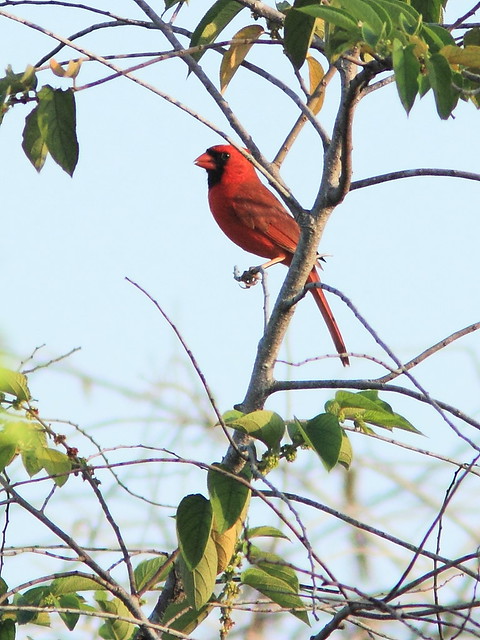
The air was calm, just perfect for capturing the reflection of this Great Egret.

I was disappointed to see that the recreational off-road vehicle drivers had not only knocked down the "No Trespassing" sign but had dragged it out into the road, as if to flaunt their indifference.
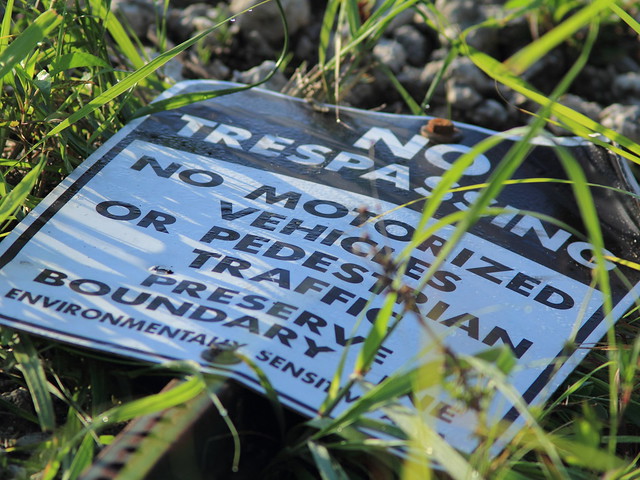
After walking the full length of the mile-long road, I pushed on to check up on the Yellow-crowned Night-Heron rookery, as I was anxious to see what had happened there since we left for Illinois a month previously. At that time I observed courtship and recorded the locations of nests under construction. I assigned a number to each nest, relating it to the position of the 30 regularly spaced live oaks that had been planted along the near side of the canal. The numbers run from north to south.
As I proceeded northward along the side of the canal opposite the rookery trees, I found four active Yellow-crowned Night-Heron nests. The first (#22) was in a new location and contained two nestlings. Look closely to see the red eye of one of them (click on photo to enlarge).
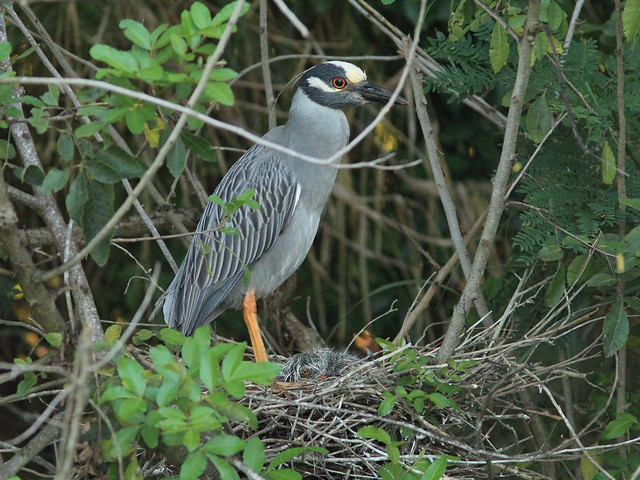
A few days I discovered a second nest (#18) within arms reach of a makeshift dock which had two or three nestlings. I could not get any good photos
A third nest (#13.5) was in the same location as in the previous year. I had re-found it the month before but now it was entirely obscured by vegetation, though I saw fresh whitewash and could discern some movement that indicated it was still active. My neighbor Scott photographed four chick at this nest the week before.
A fourth nest (#10) contained two or more blue eggs. Like the first, it was over the water and quite exposed to view.

A fifth nest (#9) was one from last year being reconstructed by a pair when I charted it before leaving for Illinois a month before, but it had disappeared.
The sixth nest (#4.5) was near the far north end of the canal, in a new location. The month before I had found an occupied nest out in the open only a few yards north of it, but now it was gone. Perhaps a storm (or vandals) had destroyed it and the nest pictured below represented a second attempt. It also contained eggs.
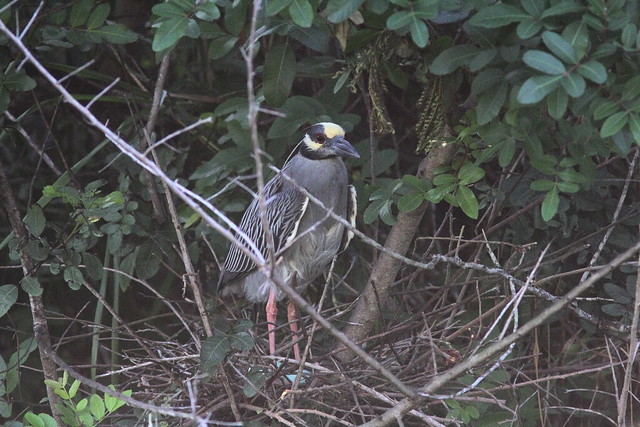
Another nest (#2.5) that was under construction a month ago had also disappeared. Last year six pairs of Yellow-crowned and three pairs of Green Herons nested in the rookery.
Green Herons are more secretive, and their nests are easy to miss. I found one new Green Heron nest at #5.5 but could only see movement through the leaves and hear one or more nestlings' begging cries as it was being fed by a parent. A second Green Heron Nest (#20.3) contained eggs on May 25.
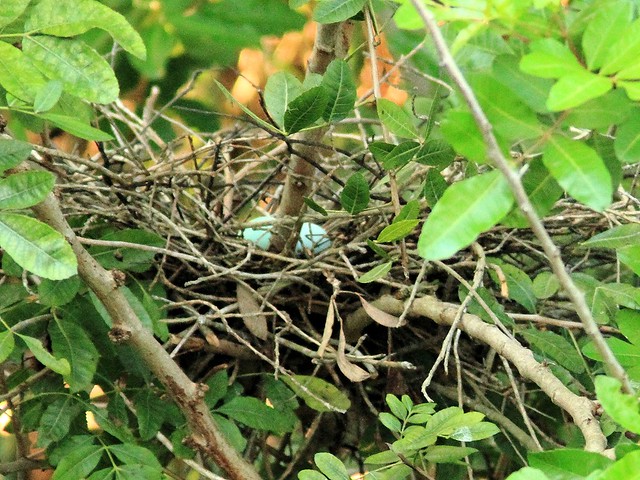
However two days later it was empty and an adult male Green Heron was roosting next to the nest but did not enter it and soon flew to a nearby branch.
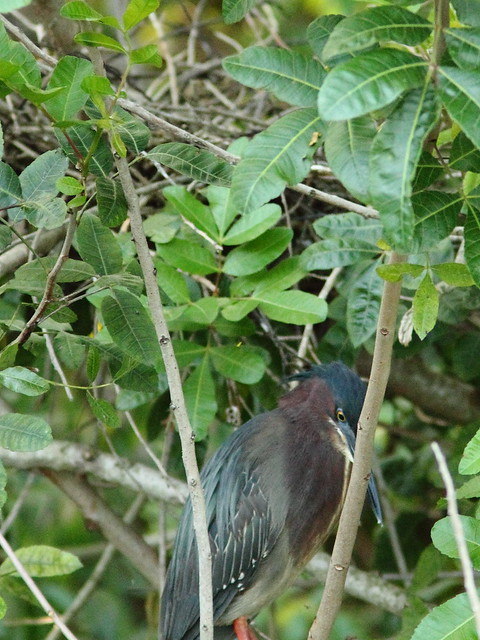
This male in breeding condition has bright reddish legs as opposed to the yellow-orange legs of the females.
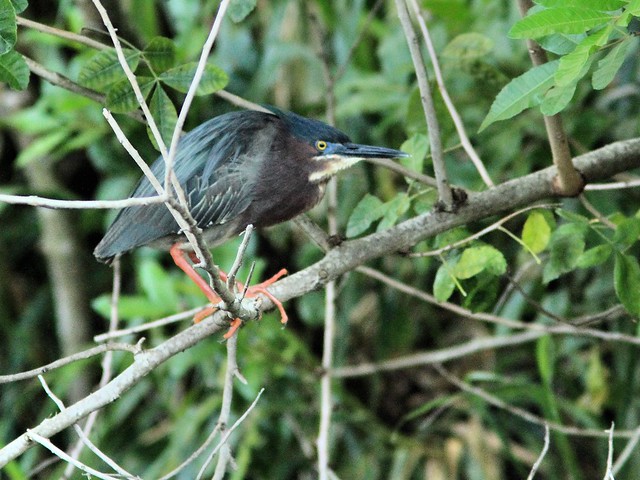
Suddenly, a very young immature Yellow-crowned Night-Heron appeared on the nest and began eating something. It probed in the nest and I took many photos it an attempt to see what it was eating-- the eggs of the other species? Only one photo gave any clue, as it appears clear that at this point the young intruder was eating some kind of insect, possibly a large beetle.
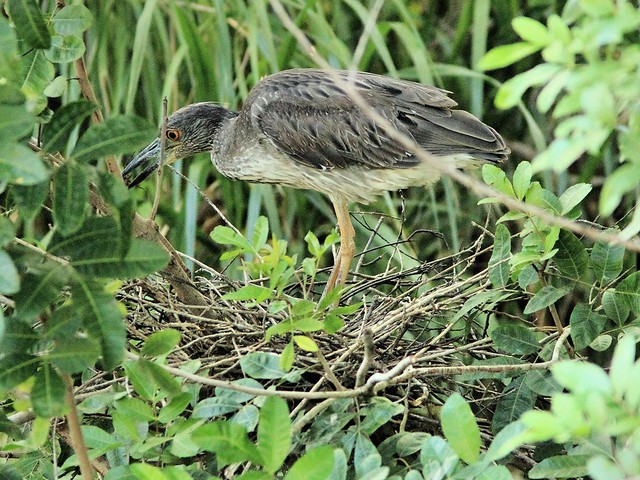
Here is a close-up of the insect in its bill.
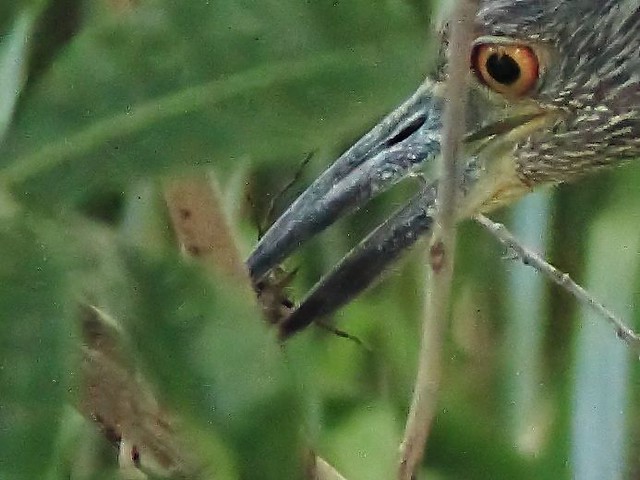
What happened to the Green Heron's eggs or young remains a mystery. Perhaps they had been destroyed withing the past 48 hours and the beetle was attracted to their remains
So far I have identified these five active Yellow-crowned Night-Heron and two Green Heron nests. I found three fledgling Green Herons that I could not associate with any particular nest. The streaked breast and the presence of a tuft of natal down identifies this Green Heron as a juvenile.
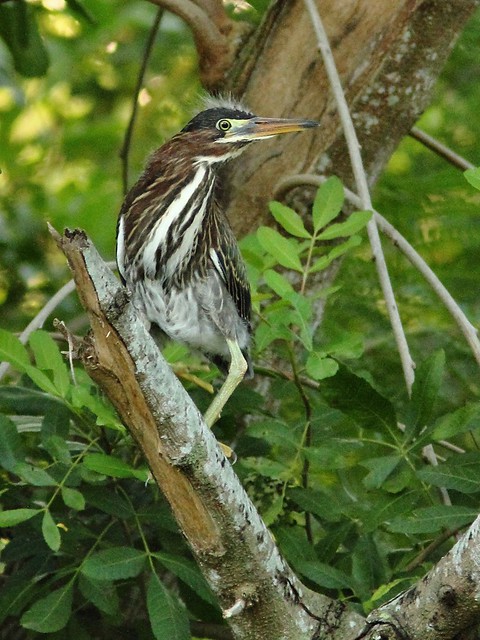
At least one other pair of adult Green Herons was present. It is quite possible that I missed some nests and will keep looking.
On my way back home I observed interesting behavior on the part of a Common Nighthawk. Last month I suspected that a pair of nighthawks was planning to nest in this area, and now saw that one of them was flying short hops just in front of a walker, evidently in an attempt to lead him away from the nest.
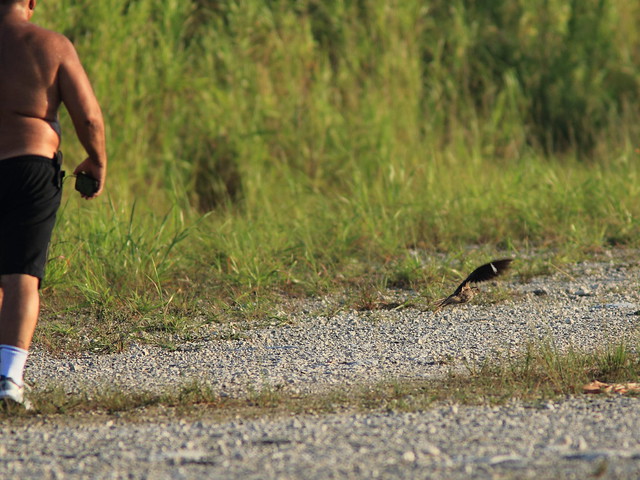
I quietly watched as the nighthawk returned to a spot that I assumed may have been the nest site. Being very careful about where I planted my feet, I ventured a short distance off the side of the road and saw an empty egg shell but no evidence of a hatchling.
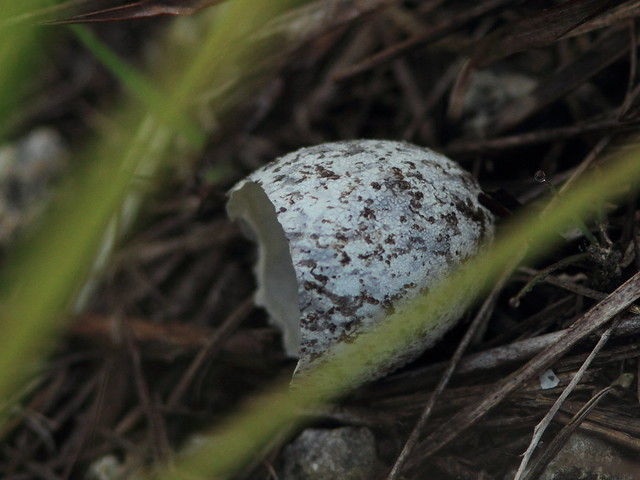
Of course a baby bird could well have been right in front of my eyes as they are so well camouflaged. In the meantime the nighthawk landed a short distance away and waited for me to depart. As I left it actually walked (almost ran) in front of me before taking short flights as I followed it away from the nest area.
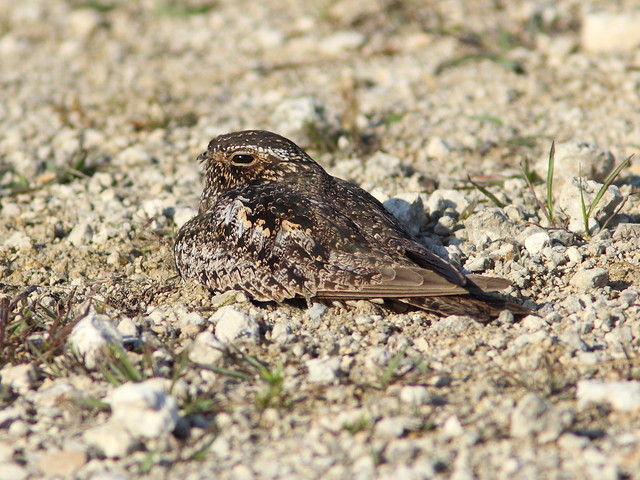
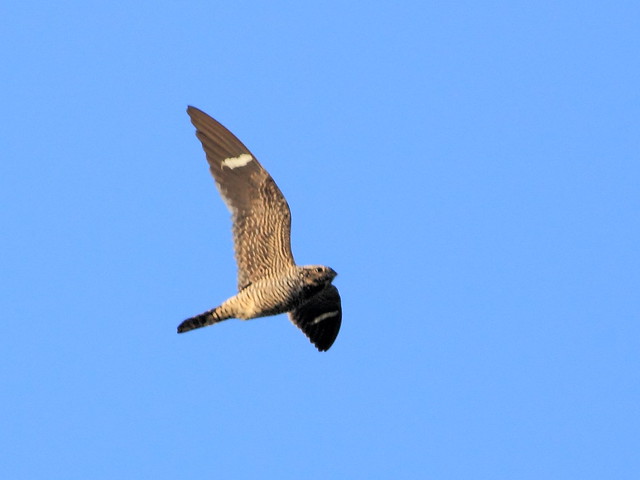
once again, great spotting, and GREAT shots! wonderful post FULL of stuff. :)
ReplyDeleteGorgeous photos! The photo of the egret is stunning. It's always sad to see how little some care about nature and our surroundings.
ReplyDeleteLove the Herons shots and the Nighthawk is awesome. Wonderful post, Ken!
ReplyDeleteGreat photos!
ReplyDeleteInteresting to study!
Great photos! I loved the egret reflection shot. And the Heron photos were wonderful. The cardinal is stunning.
ReplyDeleteFantastic shots! Wow!
ReplyDeleteSuperb post, Ken! And timely, for me, as I continue to try to find breeding birds.
ReplyDeleteIt's been neat the past few trips to hear the "booming" of the Common Nighthawks at dawn as they try to attract a mate.
Fantastic photographs!
This is one of the best posts you've shared with the Bird D'Pot in my opinion....what a great series. The nests are incredible.
ReplyDeleteSorry I didn't get around to visiting yesterday...no power due to storms!!
Nice work with your nest finding and documentation Ken. It is mazing how birds will nest year after year in almost precisely trhe same locations. brilliant shots of the herons too, not to mention the nighthawk. Your naming conventions appear to be just like ours - makes sense to us anyway but probably not to non-birder proof readers.
ReplyDeleteA wonderful post... many thanks for sharing.
ReplyDeleteSweet! Very wonderful photos I have only seen blue herons around here.
ReplyDeleteFantastic photos! Love the herons! They're among my favorite birds. The Nighthawk photo is great, too!
ReplyDeleteGreat photos and an interesting post with your observations of the nesting birds. I especially like the photo of the Great Egret and its reflection.
ReplyDeleteOh just fabulous captures Ken!
ReplyDeleteWonderful shots of the herons!
ReplyDeleteThanks for taking us down that gravel path!
gorgeous image of the nighthawk. And thanks for the info of it´s behaviar. :)
ReplyDeleteWow.... a mega post. Just love the yellow crowned night heron, a very smart bird and to get shots of Nighthawks in the open would be a dream for most people, very well done
ReplyDeleteAs I said above when I was in my Birding Blog Admin, I think this post is outstanding. And it was well worth looking through once again. I love 'em all Ken. [That egret reflection is awesome]
ReplyDeleteBy the way, I love your stance on photographing something and then following through with the motion of the binoculars!! We need to protect our feathered friends...a lot!!
Beautiful. I had not seen a night heron before. That baby bird is tiny and leaving dangerously.
ReplyDeleteI think that Nighthawks are such marvelous birds, reminds me of Whiporwills and Chuck-wills Widows...very neat birds, all of them~
ReplyDeleteWonderful sightings! I have never seen a Yellow-crowned Night-heron in person...but would love to!
ReplyDeleteGreat series showing all the nests. The second shot is artistically divine!
ReplyDeleteAll the birds are wonderful and the nest photos make me gasp in utter awe -- I'll probably never see those, so I am incredibly grateful to you for sharing.
ReplyDeleteI guess I've been misplacing hyphens as I watch birds for a long time. Now I find I'm an amateur speller as well as an amateur birder and photographer.
I did a post about nighthawks once because they were the first bird I ever wondered about (when I was a child). I didn't find out what they were until I was all grown up with children of my own.